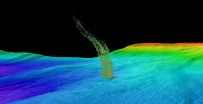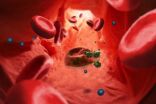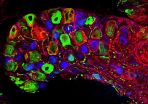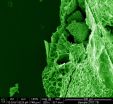Myriad myRisk™ Hereditary Cancer Improved Detection of Mutations by 105 Percent An analysis of 17,142 patients with breast cancer showed 9.5 percent of females (n=1,608) were positive for at least one deleterious or suspected deleterious gene mutation. The myRisk Hereditary Cancer test found BRCA1 and BRCA2 comprised 49 percent of the identified mutations, and 51 percent of the mutations were in other genes, representing a 105 percent increase in mutation detection over BRCA testing alone. Many of these newly identified mutations were in other breast cancer genes such as: PALB2, CHEK2, ATM and NBN. Additionally, less than 1 percent of patients had a mutation in a gene not associated with breast cancer, reducing any concerns about unanticipated results. "Our myRisk Hereditary Cancer test is making a major scientific contribution to our understanding of hereditary cancer risk and more importantly to patient care," said Richard Wenstrup, M.D., chief medical officer, Myriad Genetic Laboratories. "We believe panel testing provides valuable information and guidance both for the management of the patient and the patient's family members." Myriad myChoice™ HRD Predicted Response in Early TNBC In this study, researchers at Dana-Farber Cancer Institute and several other leading cancer research institutions validated the use of the myChoice HRD test in the neoadjuvant setting with TNBC. myChoice HRD is the first and only comprehensive companion diagnostic test to detect a DNA scar in tumor that is indicative of a dysfunctional DNA repair pathway. The study results demonstrated that 52 percent of patients with a deficiency defined by myChoice HRD responded to platinum-based treatment compared to only 10 percent of patients with intact HRD (P=0.001). Importantly, 28 percent of patients in the deficient HRD group had a pathologic complete response compared to none in the intact HRD group. myChoice HRD may assist in selecting the best chemotherapy for TNBC patients before they have surgery when there is the greatest opportunity to affect a positive outcome. Patients with a deficient HRD status are likely to respond to platinum-based therapies, while patients with an intact HRD state are unlikely to respond and could be spared the added toxicity associated with these medicines. Myriad intends to make myChoice HRD available as part of an early-access program for patients with TNBC receiving platinum-based therapy in the neoadjuvant setting in the next calendar year. The Company also has several ongoing collaborations with pharmaceutical companies to evaluate myChoice HRD as a companion diagnostic for other agents such as PARP inhibitors and in other tumor types beyond breast cancer.
BRACAnalysis® Predicted Response in Metastatic TNBC Researchers at the UK-based Institute for Cancer Research evaluated the use of companion diagnostic assays to evaluate 310 patients with metastatic TNBC to identify which patients would respond to carboplatin or docetaxel. A key finding from this analysis is that BRACAnalysis showed that 68 percent of patients with a germline BRCA mutation had an objective response to treatment with carboplatin, compared to only 33 percent of patients who received docetaxel (P=0.03). Importantly, there was no difference between carboplatin and docetaxel in patients without a germline BRCA mutation. Additional analysis is underway to evaluate the ability for tumor BRACAnalysis to further broaden the number of metastatic TNBC patients who could benefit from carboplatin therapy. The Company also has several ongoing research collaborations with pharmaceutical companies to evaluate BRACAnalysis as a companion diagnostic for PARP inhibitors and is currently supporting 13 Phase 3 clinical trials in three cancer types and various treatment settings. "These results are important because metastatic TNBC is difficult to treat, and physicians need tests to better select which patients are likely to respond to a platinum drug. We are rapidly developing companion diagnostic tests to help target therapies for patients across the spectrum of TNBC," said Wenstrup. "The studies presented at SABCS answer important clinical questions about which patients with TNBC will respond to platinum-based therapies in both early and advanced stages and which patients are unlikely to respond."
INFORMATION:
About Myriad myRisk™ Hereditary Cancer Testing
The Myriad myRisk Hereditary Cancer test uses next-generation sequencing technology to evaluate 25 clinically significant genes associated with eight hereditary cancer sites including: breast, colon, ovarian, endometrial, pancreatic, prostate and gastric cancers and melanoma. For more information visit: http://www.myriad.com/products-services/hereditary-cancers/myrisk-hereditary-cancer/.
About Myriad myChoice™ HRD
Myriad's myChoice HRD test detects DNA scars that are indicative of a tumor that has lost the ability to repair double-stranded DNA breaks, resulting in increased susceptibility to DNA-damaging drugs. Deficient tumors identified by myChoice HRD scores are reflective of DNA repair deficiencies and are prevalent in all breast cancer subtypes and many other major cancers. In previously published data, Myriad showed that myChoice HRD accurately predicted drug response to platinum therapy in triple-negative breast cancer patients. It is estimated that up to 1.8 million people in the United States and Europe are diagnosed with cancers annually and are potential candidates for treatment with DNA-damaging agents. For more information visit: http://www.myriad.com.
About BRACAnalysis®
Myriad's BRACAnalysis is a molecular diagnostic test for identifying germline (hereditary) cancer-causing mutations in the BRCA1 and BRCA2 genes. BRACAnalysis has undergone significant clinical and analytic validation. For more information visit: http://www.myriad.com.
About Myriad Genetics
Myriad Genetics is a leading molecular diagnostic company dedicated to making a difference in patients' lives through the discovery and commercialization of transformative tests to assess a person's risk of developing disease, guide treatment decisions and assess risk of disease progression and recurrence. Myriad's molecular diagnostic tests are based on an understanding of the role genes play in human disease and were developed with a commitment to improving an individual's decision making process for monitoring and treating disease. Myriad is focused on strategic directives to introduce new products, including companion diagnostics, as well as expanding internationally. For more information on how Myriad is making a difference, please visit the Company's website: http://www.myriad.com.
Myriad, the Myriad logo, BART, BRACAnalysis, Colaris, Colaris AP, myPath, myRisk, myRisk Hereditary Cancer, myChoice, myPlan Lung Cancer, BRACAnalysis CDx, HRD, Vectra and Prolaris are trademarks or registered trademarks of Myriad Genetics, Inc. in the United States and foreign countries. MYGN-F, MYGN-G
Safe Harbor Statement
This press release contains "forward-looking statements" within the meaning of the Private Securities Litigation Reform Act of 1995, including statements relating to Myriad myRisk Hereditary Cancer test making a major scientific contribution to patient care; panel testing providing valuable information and guidance both for the management of the patient and the patient's family members; myChoice HRD assisting in selecting the best chemotherapy for TNBC patients before they have surgery when there is the greatest opportunity to affect a positive outcome; the Company rapidly developing companion diagnostic tests to help tailor therapies for patients across the spectrum of this difficult to treat cancer; the Company's intent to make myChoice HRD available as part of an early-access program for patients with TNBC receiving platinum-based therapy in the neoadjuvant setting in the next calendar year; several ongoing collaborations between the Company and pharmaceutical companies to evaluate myChoice HRD as a companion diagnostic for other agents such as PARP inhibitors and in other tumor types beyond breast cancer; the potential for tumor BRACAnalysis to further broaden the number of metastatic TNBC patients who could benefit from carboplatin therapy; several ongoing research collaborations between the Company and pharmaceutical companies to evaluate BRACAnalysis as a companion diagnostic for PARP inhibitors and it is currently supporting 13 Phase 3 clinical trials in three cancer types and various treatment settings; the importance of the results for BRACAnalysis in metastatic TNBC and physicians' need for tests to better select which patients are likely to respond to a platinum drug; the Company rapidly developing companion diagnostic tests to help target therapies for patients across the spectrum of TNBC; and the Company's strategic directives under the caption "About Myriad Genetics." These risks and uncertainties include, but are not limited to: the risk that sales and profit margins of our molecular diagnostic tests and pharmaceutical and clinical services may decline or will not continue to increase at historical rates; risks related to our ability to transition from our existing product portfolio to our new tests, including unexpected costs and delays; risks related to changes in the governmental or private insurers reimbursement levels for our tests or our ability to obtain reimbursement for our new tests at comparable levels to our existing tests; risks related to increased competition and the development of new competing tests and services; the risk that we may be unable to develop or achieve commercial success for additional molecular diagnostic tests and pharmaceutical and clinical services in a timely manner, or at all; the risk that we may not successfully develop new markets for our molecular diagnostic tests and pharmaceutical and clinical services, including our ability to successfully generate revenue outside the United States; the risk that licenses to the technology underlying our molecular diagnostic tests and pharmaceutical and clinical services and any future tests and services are terminated or cannot be maintained on satisfactory terms; risks related to delays or other problems with operating our laboratory testing facilities; risks related to public concern over our genetic testing in general or our tests in particular; risks related to regulatory requirements or enforcement in the United States and foreign countries and changes in the structure of the healthcare system or healthcare payment systems; risks related to our ability to obtain new corporate collaborations or licenses and acquire new technologies or businesses on satisfactory terms, if at all; risks related to our ability to successfully integrate and derive benefits from any technologies or businesses that we license or acquire; risks related to our projections about our business, results of operations and financial condition; risks related to the potential market opportunity for our products and services; the risk that we or our licensors may be unable to protect or that third parties will infringe the proprietary technologies underlying our tests; the risk of patent-infringement claims or challenges to the validity of our patents or other intellectual property; risks related to changes in intellectual property laws covering our molecular diagnostic tests and pharmaceutical and clinical services and patents or enforcement in the United States and foreign countries, such as the Supreme Court decision in the lawsuit brought against us by the Association for Molecular Pathology et al; risks of new, changing and competitive technologies and regulations in the United States and internationally; and other factors discussed under the heading "Risk Factors" contained in Item 1A of our Annual Report on Form 10-K for the fiscal year ended June 30, 2014, which has been filed with the Securities and Exchange Commission, as well as any updates to those risk factors filed from time to time in our Quarterly Reports on Form 10-Q or Current Reports on Form 8-K.








